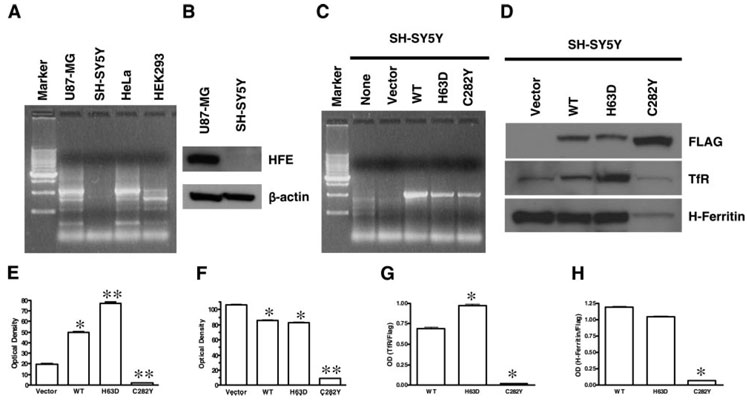Stable SH-SY5Y HFE Expressing Cell Lines
The human neuroblastoma SH-SY5Y cell lines are a useful cell culture model for studying neurodegenerative diseases due to their neuronal characteristics.
Highlights:
- Superior, SH-SY5Y-based cell model does not express endogenous HFE
- Available HFE variants include Wild type, H63D, and C282Y
- Also available as a kit of Wild type, H63D, and C282Y
These stable cell lines express variants of the hemochromatosis gene (HFE), which codes for a major histocompatibility complex class I-like protein (MHC I) that regulates the interaction of the transferrin receptor with transferrin, implicating the gene in iron absorption. This SH-SY5Y-based cell model is superior to other models (e.g. HEK293 and HeLa cell-based systems) due to the fact that basal HFE is not present in this cell type.
Polymorphisms in the HFE gene are one of the common genetic variants in Caucasians. There are two primary genetic variants, C282Y and H63D. These variants have been identified as potential risk factors for hereditary hemochromatosis (HH), cancer, and a number of neurodegenerative diseases including Alzheimer’s disease (AD) and amyotrophic lateral sclerosis (ALS). In addition, the different HFE gene variants are associated with differences in response to therapeutic interventions.
From the laboratory of Sang Y. Lee, PhD, Penn State College of Medicine.
 Part of The Investigator's Annexe program.
Part of The Investigator's Annexe program.
The human neuroblastoma SH-SY5Y cell lines are a useful cell culture model for studying neurodegenerative diseases due to their neuronal characteristics.
Highlights:
- Superior, SH-SY5Y-based cell model does not express endogenous HFE
- Available HFE variants include Wild type, H63D, and C282Y
- Also available as a kit of Wild type, H63D, and C282Y
These stable cell lines express variants of the hemochromatosis gene (HFE), which codes for a major histocompatibility complex class I-like protein (MHC I) that regulates the interaction of the transferrin receptor with transferrin, implicating the gene in iron absorption. This SH-SY5Y-based cell model is superior to other models (e.g. HEK293 and HeLa cell-based systems) due to the fact that basal HFE is not present in this cell type.
Polymorphisms in the HFE gene are one of the common genetic variants in Caucasians. There are two primary genetic variants, C282Y and H63D. These variants have been identified as potential risk factors for hereditary hemochromatosis (HH), cancer, and a number of neurodegenerative diseases including Alzheimer’s disease (AD) and amyotrophic lateral sclerosis (ALS). In addition, the different HFE gene variants are associated with differences in response to therapeutic interventions.
From the laboratory of Sang Y. Lee, PhD, Penn State College of Medicine.
 Part of The Investigator's Annexe program.
Part of The Investigator's Annexe program.
| Catalog Number | Product | DataSheet | Size | AVAILABILITY | Price | Qty |
|---|
| Product Type: | Cell Line |
| Cell Type: | Neuroblastoma (SH-SY5Y) |
| Accession ID: | Q30201 |
| Organism: | Human |
| Morphology: | Epithelial (C282Y variant aggregates well and forms clumps) |
| Source: | Brain |
| Fusion Tag(s): | DYKDDDDK peptide (the same epitope recognized by Sigma's Anti-FLAG®* antibodies) |
| Biosafety Level: | BSL-1 |
| Subculturing: | 1:20 - 1:40 |
| Growth Conditions: | DMEM/F12, 10% FBS, 1x Non-essential amino acids, 250ug/mL Geneticin |
| Cryopreservation: | Complete culture medium supplemented with 10% DMSO |
| Vector Information: | pcDNA 3.1 vector |
| Target Gene / Reporter(s): | HFE Wild type, HFE H63D, HFE C282Y, Vector Only |
| Comments: | *Anti-FLAG® is a registered trademark of Sigma-Aldrich. |
| Storage: | Liquid nitrogen |
| Shipped: | Dry ice |
Expression of HFE in human brain-derived cell lines and effect of overproduction of HFE.

A) RNA expression of HFE measured by RT-PCR. HFE mRNA was detected by using a primer designed to make an 1101 bp PCR product. The gel was representative picture of staining by EtBr. Marker; 500 bp DNA ladder. B) A representative immunoblot of HFE and beta-actin expression. C) Expression of HFE gene by PCR in HFE stably transfected cells. DH) Effect of overexpression of HFE in stably transfected SH-SY5Y cells. Cells were grown for 4 days in standard media, then the expression of transferrin receptor (TfR) and ferritin was determined. D) A representative blot; E, F) data from four different experiments. G, H) A densitometric analysis of the Western blots for TfR and H-ferritin compared with FLAG expression. The asterisk (*) indicates a significant difference compared with vector-transfected cells and a double asterisk (**) indicates a significant difference compared with WT HFE cells (P 0.05, n 5).
Adapted from: Lee SY et al. Consequences of expressing mutants of the hemochromatosis gene (HFE) into a human neuronal cell line lacking endogenous HFE. FASEB J. 2007. 21(2):564-576.
- Lee SY et al. Consequences of expressing mutants of the hemochromatosis gene (HFE) into a human neuronal cell line lacking endogenous HFE. FASEB J. 2007. 21(2):564-576.
- Lee SY, Liu S, Mitchell RM, Slagle-Webb B, Hong Y, Sheehan JM, and Connor JR. HFE polymorphisms influence the response to chemotherapeutic agents via induction of p16INK4A. International Journal of Cancer 2011. 129:2104-2114.
- Liu Y, Lee SY, Neely E, Nandar W, Moyo M, Simmons Z, Connor JR. Mutant HFE H63D protein is associated with prolonged endoplasmic reticulum stress and increased neuronal vulnerability. JBC 2011. 286(15):13161-13170.
- Wang XS, Lee S, Simmons Z, Boyer P, Scott K, Liu W, Connor J. Increased incidence of the Hfe mutation in amyotrophic lateral sclerosis and related cellular consequences. J Neurol Sci. 2004 Dec 15;227(1):27-33.
- F. Ali-Rahmani, P. Grigson, S. Lee, E. Neely, J.R Connor, and C-L. Schengrund. H63D mutation in HFE alters cholesterol metabolism and induces memory impairment. Neurobiol. Aging. 2014. 35(6):1511.e1-1511.e12.
- Fatima Ali-Rahmani, Michael A. Huang, C-L. Schengrund, James R. Connor, and Sang Y. Lee. C282Y-HFE Gene Variant Affects Cholesterol Metabolism in Human Neuroblastoma Cells. PLoS ONE. 2014. 9(2):e88724.
If you publish research with this product, please let us know so we can cite your paper.


